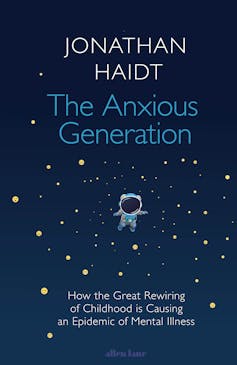The social psychologist Jonathan Haidt’s new book The Anxious Generation delivers an urgent call for action.
Haidt argues that the evidence is in. Teenagers’ widespread use of smartphones is causing a mental health crisis. Individual, collective and legislative action is required to limit their smartphone access.
Review: The Anxious Generation: How the Great Rewiring of Childhood is Causing an Epidemic of Mental Illness (Allen Lane)
Haidt begins his book with an allegory. Imagine someone offered you the opportunity to have your ten-year-old child grow up on Mars, even though there is every reason to believe that radiation and low gravity could greatly disrupt healthy adolescent development, leading to long-term afflictions. Surely, given the risks, you would refuse the offer.
A decade ago, parents could not have known the threats lying within the shiny new smartphones they presented to their excited teenagers. But the evidence is mounting that the children who grew up with smartphones are struggling.
Haidt calls the period from 2010 to 2015 the “great rewiring”. This was a period when adolescents had their neural systems primed for anxiety and depression by extensive daily smartphone use.
The kids aren’t alright

Haidt’s two central claims are that Gen Z is suffering from a major mental illness epidemic and that smartphones are largely to blame.
Readers should be wary about both these claims – not in the sense that we should resist believing them, but rather we should not be too eager to embrace them. After all, it is perilously easy to believe that the kids aren’t alright. Elders routinely despair of the younger generation.
Haidt explicitly acknowledges that other experts have argued against claims of widespread teenage anxiety. In response, he cites recent evidence from a host of different sources: not just self-reports of problems, but hard data on self-harming, suicide rates, diagnosed mental disorders and mental health hospitalisations.
While Haidt focuses on the US, he observes concurrent shifts in youth mental health in many Western countries, including Australia.
But do these findings constitute an epidemic demanding society-wide responses? Here the book would have benefited from systematically drawing together the science in easily understandable terms.
Haidt’s marshalled evidence consistently shows a rise, beginning around 2010 and starting with girls, in a host of adolescent mental health disorders and wellbeing concerns. Broadly speaking, the figures in the US show mental health issues that previously plagued around 5-10% of adolescents growing to afflict around twice that amount.
On the one hand, these data suggest the term “anxious generation” is somewhat misleading. A large majority of Gen Z do not have anxiety disorders – and of those who do, almost half would have done so irrespective of smartphone usage.
On the other hand, the numbers remain concerning. No parent would be comfortable handing their child any substance they knew had a one-in-ten chance of causing the child a mental disorder within a few years. There are also data suggesting that, even among those without disorders, children increasingly suffer from loneliness and other concerning outcomes.
Perhaps the most alarming part of the steep curves and precipitous falls in Haidt’s many graphs is not the current figures, but the current trajectories. In almost all cases, things are getting worse. It is possible we may be in the early days of an unfolding catastrophe.

Read more: No, you're probably not 'addicted' to your smartphone – but you might use it too much
Insert your ideological preference
If we accept there is a serious problem, then the question arises as to its cause. Again, we must resist intuitively appealing answers to this question. The worry is that we will all look into a “witch’s mirror”, seeing what we want to see or what our preferred ideology tells us we should expect. I am old enough to remember panics about heavy metal music and Dungeons & Dragons.
Indeed, it is possible that Haidt himself fell into this trap, at least in part. In a previous book, The Coddling of the American Mind, Haidt and his co-author Greg Lukianoff argued that harmful worldviews and beliefs prevalent in US educational settings were priming young people for worrying mental health outcomes.

Haidt thinks this coddling remains a factor, but now recognises the hypothesis fails to fit the data. Specifically, he acknowledges the plummeting mental health of adolescents is evident in many countries, and across all educational levels and social classes.
Are there alternative hypotheses that fit this data? Perhaps kids today are anxious and depressed because they should be anxious and depressed? After all, they inherit a world facing runaway global warming, systemic injustices, insecure work futures and more. Yet Haidt rightly observes that past generations with dire prospects did not show similar mental health outcomes.
Ultimately, the problem is likely to stem from a mix of factors. Haidt argues the current situation was not caused exclusively by smartphone use. Recent decades have also seen the rise of “safetyism” – a term he and Lukianoff coined to describe the preferencing of individual safety ahead of other values – and helicopter parenting. These phenomena have increasingly shielded children from the vital development provided by physical play and unsupervised exploration of the real world.
Haidt argues that parents became fearful of the healthy risks posed by the outside world, even as they catastrophically opened their children up to the unhealthy dangers of the virtual world.
Read more: Too much love: helicopter parents could be raising anxious, narcissistic children
Developmental concerns
Smartphones did not initially raise major developmental concerns for children. The problems started around 2010 when they combined with other factors like social media, high-speed internet, a backward-facing camera (encouraging selfies), addictive games, easily accessible pornography, and free apps that maximise profit by cultivating addiction and social contagion.
This toxic technological mix allowed smartphones to take over children’s lives. Usage rates averaging seven hours a day gradually but profoundly rewired their maturing brains. Haidt thinks this rewiring gives rise to four “foundational concerns”:
Social deprivation: a smartphone is an “experience blocker”, taking up hours a day that would otherwise be spent in physical play or in-person conversations with friends and family.
Sleep deprivation: too many teenagers stay on their smartphones late at night when they need rest.
Attention fragmentation: alerts and messages continually drag teenagers away from the present moment and tasks requiring concentration.
Addiction: apps and social media are deliberately designed to hack vulnerabilities in teenagers’ psychologies, leading to an inability to enjoy anything else.
Building on these foundational concerns are ones specific to each gender. Girls proved more vulnerable to the damaging effects of social media, while boys retreated into online gaming and pornography.
Dangers to adolescent mental health
An intriguing part of Haidt’s book is its account of the way smartphones became addictive and damaging.
Teenagers, like all humans, have several basic needs and emotional drivers: for social connection and inclusion, for a sense of individual empowerment and agency, for sexual fulfillment, and so on.
Haidt explains that, normally, for almost all human history and evolution, these incentives drove teenagers to do things in person, in the real world – things like making friends, playing games together, navigating disputes, getting tasks done, developing romantic attachments and taking physical risks.
While these activities can lead to injuries, tears and frustrations, they are nevertheless important for teenagers’ mental health and development. Children are antifragile: they need these types of risks and stressors to grow properly.
Smartphones – and their apps, games and social media – also provide responses to all these drivers. But they do so without prompting the above activities and the important outcomes they deliver, such as close friendships and resilience.
For example, a teenager might feel lonely and want connection, so they join Instagram or TikTok. Social media provides a type of connection and delivers a temporary dopamine hit. But it fulfils the teenager’s immediate need in a way that does not involve real world connections and challenges. This only makes them lonelier and more isolated in the longer term.

What can we do?
Even if we accept Haidt’s claims about the rise in anxiety fuelled by smartphones, it is not clear how we should respond. Perhaps radical solutions are unnecessary. In time, things might work themselves out, such as through further technological innovations.
Haidt’s view is that collective action is critical. As he sees it, the problem is not only that smartphones are intrinsically useful and alluring (which is why we all wanted them in the first place); it is not only that their apps are addictive. The problem – especially in a school setting – is that if most of a teenager’s peers have smartphones, then the ones who don’t have one risk being social outcasts, perpetually “left out” and never “in the know”.
For this reason, Haidt thinks actions by isolated parents are unlikely to be successful. Ironically, the same heightened parental concern for child safety Haidt has previously critiqued may prove to be a powerful force for change. At least some parents are likely to view their children’s future mental health as a non-negotiable good and treat smartphones as the modern-day hypodermic needle.
For his part, Haidt argues for four new norms, to be created by parents’ collective action alongside legislative and regulatory reforms:
No smartphones before high school
No social media before 16
Phone-free schools
More independence, free play, and responsibility in the real world.
A deeper problem
Haidt’s book leaves the reader with a further, deeper worry.
Suppose he is right that the things that lead to human flourishing involve real world physical encounters with other people: family, close friends, romantic partners, neighbours, local community groups and members.
Such encounters are often unpredictable, messy, inconvenient and frustrating. Conversely, the online world is becoming easier, cheaper and more alluring every day. Innovations and algorithms continually hone our experience, as profit-driven industries work ever more aggressively to capture and keep our attention.
In the face of all this, it may be that the real world can’t compete. The mental health concerns currently plaguing Gen Z might turn out to be ones that every generation will face.
If so, Haidt’s suggested reforms might mark the first foray in what will be a long battle between the human need for real-world experience and connection, and the powerful temptations of an online world that offers something we can’t possibly resist: “a little bit of everything, all of the time”.

